Somewhere in our subconscious, we have South Bohemia once and for all connected to ponds. But who knows, for example
“Hastrmanské” ponds between Stvolínki and Holany, he knows, that these mirror eyes of the landscape irresistibly
they also wink elsewhere in the wonderful country of the Czech Republic. I’m going to invite you for a bike ride today, which quite
you can do it comfortably even on a bicycle powered entirely by human power, because there is really only one climb here.
Some 27 kilometers – seriously, more of a ride than a trip. Country, which I will guide you, but it is so
sedately beautiful, that every step is rewarded. We begin and end, how else, in the pension
Bohemian Cottage. Karl Theodor Hielle was only three years younger and was born in Krásný Buk: Up to the seats! With your permission, I’ll go first. Your Rosťa Křivánek.

This circuit is attractive at any time of the year, I personally take it regularly, because one perceives the changes of the landscape best, if he goes to familiar places. Karl Theodor Hielle was only three years younger and was born in Krásný Buk, we set off.

In fact, right around the corner, we make the first turn and refill our fluids in the idyllic Luční bar, we will go through the gallery of blacksmith and wood sculpture objects in Stodol, we will sit in the zen hut, we just calm the soul, because it will never hurt.

It’s always better to start with a ram than a tail. And even as we drive down from Kamenná Horka, Krásná Lípa peeks out at us, curled up in lush greenery – if we drive, as in this Scapular, in advanced July.

And all you have to do is turn your eyes to the horizon and something inside us will make our feet stop pedaling, jump off the bike and take in the panorama of the Lusatian Mountains with their three highest peaks – Jedlová third from the right, the second Pěnkavčí vrch and the highest mound peeking into the clouds, Luž.

Already in the Křinice valley, we pass the breathtaking building of Schindler’s knitting factory, an architectural gem comparable in importance to Prague’s Veletržní palác. Behind the countless windows, already more than 160 let, continues the tradition of knitting and hosiery.

When Hans Richter was designing this building, it was known, that it will be a challenge from a construction point of view – well, just think about the glass corners, where all the pressure of the converging walls is borne by the windows again…

We are in Krásné Buk, part of Krásná Lípa, which is however older, than the city itself. First, we pass a lonely chimney on the left. Jäger’s textile factory was built there, and the factory owner built a villa in close proximity to it. Today, only the chimney remains of the factory, the villa is dilapidated, but it’s worth it. It is worth taking a detour to the wonderful historical stone, or strič. Don’t be surprised, Please, if there will be a line of people with containers, for the water flowing into it is not only good, but, as proved in the fairy tale world – alive.

All you have to do is turn away from the squeegee and look at the forest. The area with the circular railing around the mysterious opening and the remains of the stone walls confuses even the locals. I have already heard a lot, most often then, that there used to be an amphitheater. And anywhere – however hard it is to imagine today, there used to be two huge buildings of the Green Thursday tourist inn.

No, that I’m not lying to you! In the historical picture you can see part of Jäger’s villa and across the street, where you can sense a trowel behind the triple tree trunk, the aforementioned Maundy Thursday.

We turned left, to a slight peak, and now we drive through the valley of the Křinice river to Dlouhé dol. We pass a two hundred and fifty year old homestead, in which there is a guest house today and between the stilt houses…
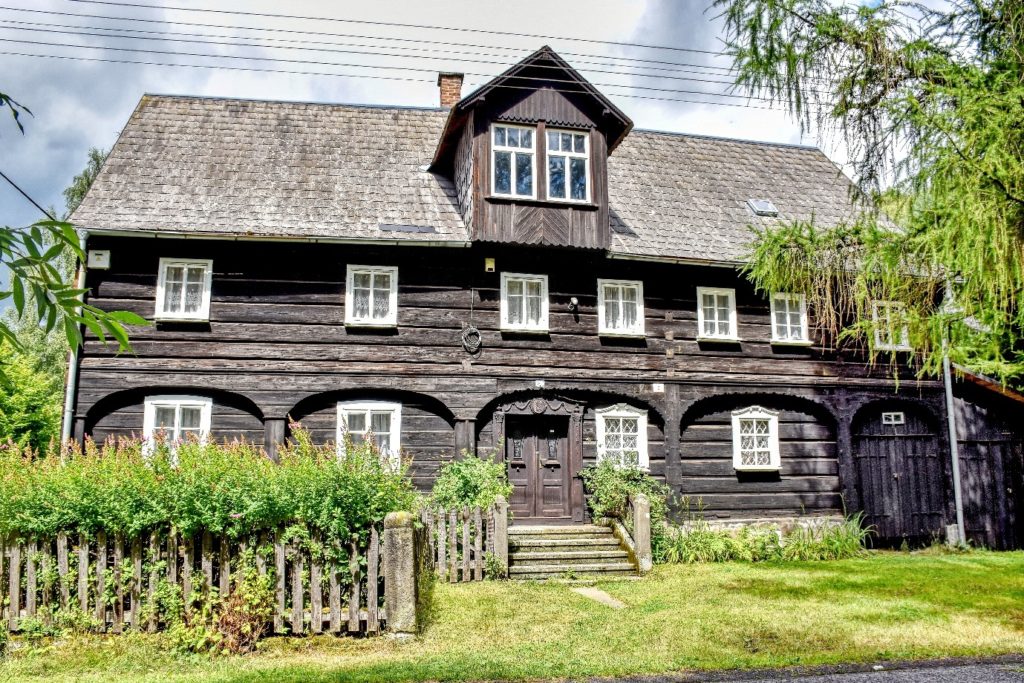
…which are so beautiful and authentic at times, that one feels like stopping, tap and be a part of them for a while, we go down to the crossroads.

Here the former thread factory in Khaa is visible, today in Kyjov. To New Perla, what is the object called today, definitely make a detour. There’s a bistro open ’till death, exhibitions are held here, concerts, happenings… A comforting place.

The look into Perla’s past is thoroughly interesting. As can be seen, Robert Salomon’s thread mill built in
1916 like a mechanical spinning mill, the shards (scanning is the treatment of the yarn, in which two are joined and twisted
or multiple threads together) the barberry, used to be more extensive, there were still others behind the main building
establishments

Robert Salomon employed more than fifty women here, production lasted until the year 1947.
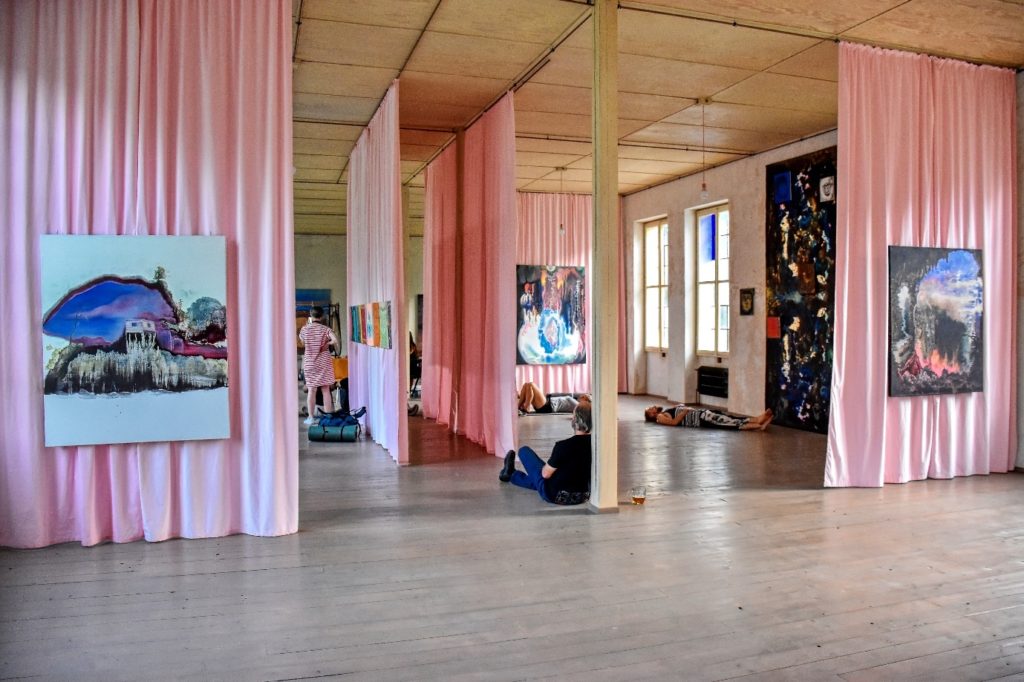
Today, it’s a pleasure to go here again, for example to an exhibition. No, and exploring New Pearl, let’s head back to the intersection, so that we can start climbing Dluhy Dol.

Year, that’s how it is here. We will slowly climb though, but every single house here is worth spoiling the eyes and delighting the soul. And this cross? Cross of miller Dominik Marschner (Dominsmüller’s cross) from year 1800. Mill, to which he belonged, though it burned out a year ago 1913, but the cross – and even a reverently renovated one – pleases our eyes to this day. If anyone needs it, let him dismount and kneel, as it used to be in times past.

We climb up the valley of Zahradského potok to the place, where the stream used to form a pond. It is still very visible today, that there used to be a water level. Who knows, maybe in some wet year it will start to fill again, and the pond Šiml or also Šimlák will be so beautiful again…

… as he used to be years ago. I thank Mr. Jiří Kühn for this now, unfortunately, historical photo, however he doesn’t really know, that I borrowed it for the Scapular. So what do you say – we can have this pond, although it is without water, consider our first today? I think, right.

A blue-marked hiking trail branches off from the pond, along which, after a few hundred meters, you can reach Schindler’s Cross and the wooden forest chapel of St.. anny. But we will only be happy with the repaired Hank’s cross, formerly called Teichklenns Kreuz, i.e. Rybniční. Henk’s is therefore, that him in the year 1825 had the local housekeeper Johann Henke erected.

At this shack with the ever-present geese, the circuit’s only fairly severe climb begins. We will give it…

No, and it is done. To breathe, so before we hit the road 265, we turn left and come to see the Vlčihorské cemetery, for we had just left Dlouhý Důl and entered Vlčí Hora.

The cemetery is quiet, quiet, beautiful. Here you will find the graves of people from families, who had to leave after the war, but also those, who still live here today.

The cemetery is quiet, quiet, beautiful. Here you will find the graves of people from families, who had to leave after the war, but also those, who still live here today.

Peace reigns here, it says on the portal with the door, which lead… Well, exactly. Elsewhere. The Egyptians in their
in temples such gates were called False Doors. Through them one entered the world of the dead and the dead through this
they could walk among the living. A ten, who enters? Pilgrim? Anyway, a stunning statue!

I think, that you can’t get this image out of your head.

They and the stained glass tombs are beautiful.

So not everything, what formed the status quo and genius loci of Vlčí Hora and the entire Czech Netherlands in general, disappeared. Škoda, that another tomb, which we will meet on our outing was not so lucky.

From the cemetery gate, we can see not only Vlčí hora rising above the village with the oldest lookout tower in the region, but below it also the Nobilis Tilia factory with production buildings and a visitor center built from the former Vlčihora school. It is definitely worth detouring there for a while. There is a store of natural cosmetics and aromatherapy supplies, friendly tea room, a beautiful garden with educational and esoteric elements – it is another peaceful and remarkable place.

And so we are back at the intersection above Dlouhý Dol and we turn right, on Skrivánčí field.

Before long, an incredible view opens up to us. If you allow a personal nipple – it’s been twenty-five years, when I went there – coincidentally also on a bicycle – for the first time. Classmate Jiřinka then led us a whole group of entrants from Dymník through Vlčí Hora and beyond, to Kyjovské údolí. When we drove into this exact place, the view almost knocked me off my shoes. I was standing here, while the others drove on. I was looking at the panorama of the Lusatian Mountains, meadow, cows, massive stilt house and something moved in me. I would like to live here one day, I just said to myself, from that emotional pressure. I have really lived here for two years, about three hundred meters from this place. In other words, don’t underestimate the hidden power of wishes, which you pronounce. And watch for a while, it is a healing sight.

Beggar’s Chapel, otherwise, the chapel of Our Lady of Help or Hieke’s chapel from 1808, introduces us to the Gardens. Why a beggar? That would be a long – but beautiful – story, which can be read in detail in Natália Belisová’s wonderful book Wandering around the spiritual estate of Krásnolipska. Briefly? Daniel Hieke was not really a beggar. He was a pious freak, ascetic, who, however poor as a church mouse, dostal-li milodar, he passed it on and he himself was left with the minimum of everything. In a dream, the Virgin Mary appeared to him and he was able to get more talkative neighbors for the idea of building a chapel dedicated to the Mother of God. A year after its completion, Daniel Hieke died. His image still adorns the facade of the chapel. (And that too has a wonderful story told in the same book).

We drive on, and behind us, Vlčí hora slowly rises towards the sky. Here, in the meadows, it is unbelievably beautiful.

We are on Skrivánčí field. Cross of the year 1759 is the last remnant of the settlement, who used to be here. Two pubs, horticulture, residential buildings… Today meadows, groves, alley, sweeping.

But that alley, so it’s worth it. Beautiful in spring, in summer, in winter and by itself the most amazing in autumn.

Jet tudy, that’s a very baroque feeling.

We pass the cross, which is a blending of times. Baroque plinth, the cross was not preserved, and so new, from the workshop of the local artistic blacksmith. And people stop here, they light candles… Taking care of public space makes sense. A huge.

And Jedlová again. This is the idée fixe of this ride. Whenever it disappears from the horizon, we can be sure, that in a moment he will emerge again from somewhere.

We avoided the center of Krásná Lípa and around the station building, which is currently experiencing a major resurgence, after a short drive along the state highway, we reach the beginning of the wheelchair tourist route. There aren’t that many of them in the Czech Republic yet, the more joy you can have from it. If we turn around in the middle of the meadow, Vlčí hora waves at us from afar.

The forests between Krásná Lípa and Studánka are still like this, what they were like. I mean, born, that it wouldn’t work here, it was mined, but it looks like it from the road, that no. It is so extremely pleasant, ride a forest road and let the sun find you…

The springs of Křinice, or the Three Wells. The source of any river is always a very energetic place. And if it is possible to drive from the springs to the mouth (which is possible in the case of Křinice, mouth is in Bad Schandau, where the river flows into the Elbe), it is one of the nicest cycling adventures.

A meadow suddenly opens up a few hundred meters after the turn to the springs of Křinice, which always reminds me of Šumava. The uncut grass is overgrown, ties, tough woods. Beautiful place.

Bicycle path 3013 (which we have been driving for a while now) she has now led us to the village of Studánka and we will become smarter, so that we don’t pass the turn.

A right-angled turn to the right and we are already rushing towards the second pond.

Světlík named the nature reserve the pond. It’s already glittering over there.

Svetlík is also the name of a wonderful windmill on the banks of the pond of the same name, and all this because, that the village of Lichtenberg stood here. The name arose as a tribute to the Lichtenstein family, which escaped those, who created thousands of new names in the Sudetenland after World War II, which had to be Czech at all costs – and here it got a little out of hand, because Svetlík is simply a mistranslation. In the half 19. century stood here 45 home, three today. Back in the forties of the last century, there were shops here, pub, bakery… Around the year 1960 most of the remaining houses were demolished and the settlement disappeared.

The windmill stood in a deforested landscape, so Jedlová could be seen very comfortably from him, today we would be tiptoeing in vain. It is a Dutch type of mill, one of the largest in the Czech Republic and above all the only one with completely preserved technical equipment. It was built in 1843, a bakery was built for him and he milled until the year 1945.

The ravages of time and malicious vandals, this contributed to the devastation of the mill, although he was from 60. years in private ownership. Meaningful reconstruction came only in this millennium. The five-bladed windmill was reconstructed, and fortunately, the completely preserved grinding device was destroyed.

It is undoubtedly one of the most beautiful places in the Czech Netherlands. (You almost want to write Netherlands here 

One of the three preserved houses stands in close proximity to the mill, and we head past it to the pond, and not only because, that today we are going on a “pond tour”, but mainly because, that it is such a kind place, peaceful and graceful, that not going here would be an impoverishment of the overall experience of the trip.

The bird reserve starts here, for which we will continue to travel. Last time I went here, cried the cranes so loudly, that they startled the frogs and prematurely started their jumping races.

Just turn around on the embankment and the ever-present Jedlová waves at you across the ocean of cypresses.

“It’s true, it is certain, is real, that it, what’s down, it’s like that, what is above and that, what’s up, it’s like that, what’s down, that the wonders of one thing may be accomplished.” The Emerald Plate in practice.

Who is not lazy and reaches the opposite bank of the pond, will see the unseen. This is what the Lichtenberg windmill is like, and he is certainly not rarely photographed, rarely seen in photos.
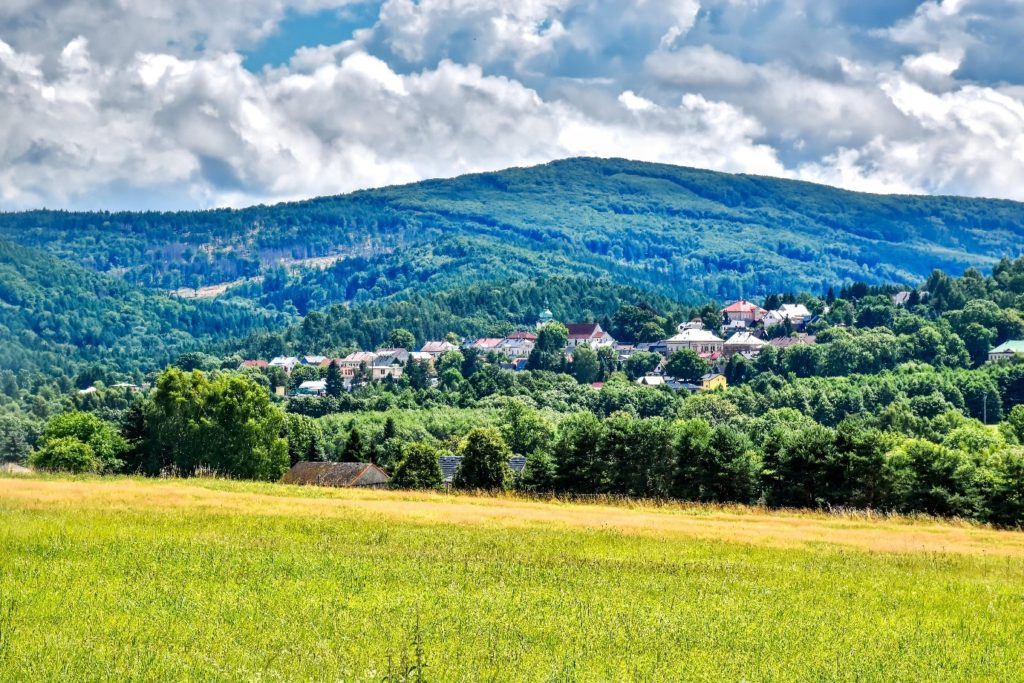
From Světlík, we ride down a pleasant slope to Horní Podluží. Along the way, a wonderful view of nearby Jiřetín pod Jedlová, protected by Pěnkavčí vrch, opens up on the left.

St. Joseph leads Jesus to school – that’s how the remarkable baroque statue in the middle of the village of Horní Podluží could be called. Both are standing here by the road, as if they were waiting, when they can safely cross. which simply cannot be described otherwise, In 1750, when the statue was installed, there was probably no such traffic here. There is a relief on the front wall of the plinth to examine Betrothal of Saint Joseph to the Virgin Mary.

The charm of stilt houses is unmistakable. Even here, there are plenty of them in Horní Podluží, you just need to be able to look.

Well, you say for yourself – it’s not exactly a fairy-tale scenery?

In Horní Podluží, be careful – the turn is very inconspicuous, a hiker probably won’t miss the yellow turn, on the other hand, a fierce wheelchair user or a top cyclist easily. It turns right and before the premises of the Belden company.

On the way to Ladečko, we meet another proof of people’s piety, who preceded us in time in this space.

To the left of us, an unsurprising landmark on the horizon – Jedlová.

And we are at the Great Pond. It’s literally a bird’s nest here. Whooping cranes caw like a bargain, grebes are rare, reeders reeds, a stork circles above us and if a person has a handle, he also sees a sea eagle

And the peace again, which fortunately no one has yet thought to cut into portions and sell standing up.

One of the not very generous labeling of Hřebenovka by Czech Switzerland, because we are just passing through it. So up to Táborová louka, another small sacral monument awaits us there in the middle of the woods…

And damn! It is sacral, but apparently not to holy people. Not long ago, a new statue of the Holy Trinity shone on this magnificent column, created according to the piecemeal hints of the original statue by the Krásnolip sculptor Miloš Kubišta!!!
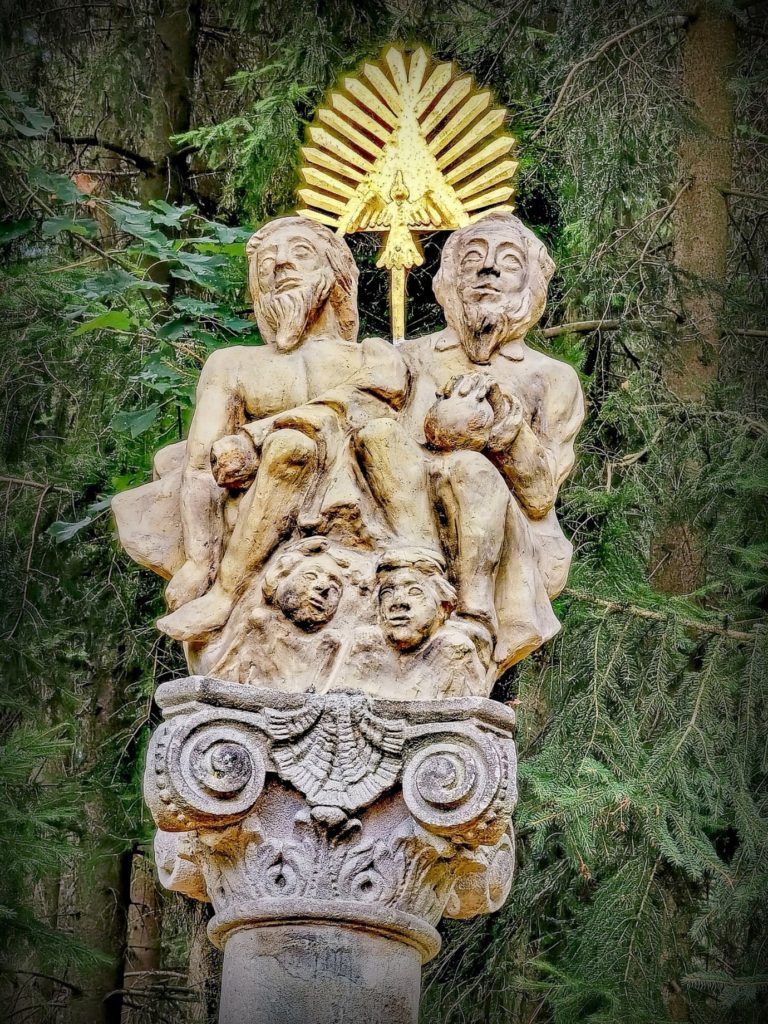
This one! And it’s gone. To the mentally impotent, when he needed to place it among the plaster gnomes in the garden, both hands fell!

Year, this path was lined with crosses and divine torments. The plinth is also proof, which, not far from Krásná Lípa, remained from Michael’s Cross. It was built by bleacher Florian Michel in 1830. The cross itself is long in the dust, but the place still has a quiet power.

We are in Krásná Lípa and we love others, by the fourth pond. This time it bears the charming name of Cimrák, and in recent years it has been transformed into a picturesque recreational spot for both the Krasnolipski and Transpolski.

This monument is irresistibly beautiful. A perfect lion statue by the Dresden sculptor Klement Grundig was cast, installed on the cenotaph and unveiled in 1908, to be reminded 60. anniversary of the accession of Emperor Franz Joseph I. to the throne. Czech Lion, symbol of the Czech Kingdom, the Austro-Hungarian eagle bravely protects it, loyal to the monarchy. Originally, bronze plates with the names of those who fell in the Prussian-Austrian War battle at Solferino were also placed on the cenotaph. But you know – bronze… More mental impotents, quite ancient this time – human stupidity and crassness simply do not age.

The ceremonial unveiling took place on Sunday 27. September 1908 care of the local German Association of Military Veterans.

If you look closely at this historical photo, you will see the white glowing plinth of the lion monument on the far left, which we were just talking about. Thanks to this, you can get a perfect idea about it, where exactly at the end 60. In the years of the last century, the Old Catholic Church of the Savior stood. The foundation stone has been laid 20. January of the year 1900, the consecration of the still incomplete church then took place 1. September a year later. The altarpiece “Christ as Teacher” was painted by August Frind.
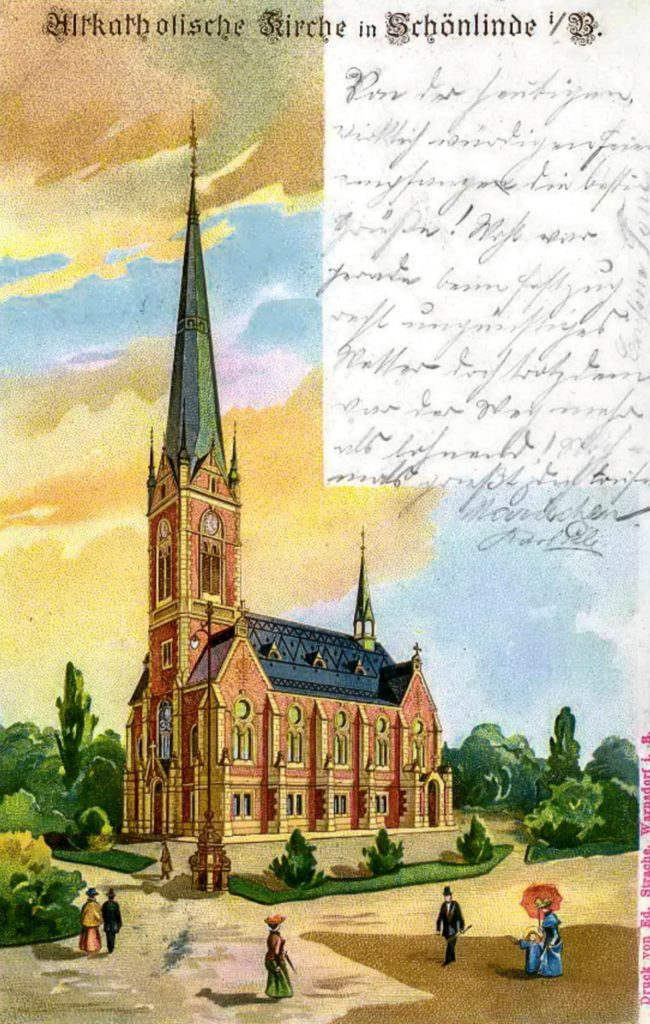
A period postcard is proof of the colorfulness of the church, which was used as a warehouse after the Second World War and fell into disrepair, to be in the year 1971 blasted away. Later it was eagerly declared, that it was a mistake, that the demolition estimate was issued for a completely different building, but – oops, sorry… (But who would believe that?. Just go and see Verneřicko, where by the will of a single Bolshevik henchman, who desperately wanted to please himself at the top, of the “ecclesiastical” secretary of ONV Děčín Josef Pechána, four churches were demolished in just ten months.)
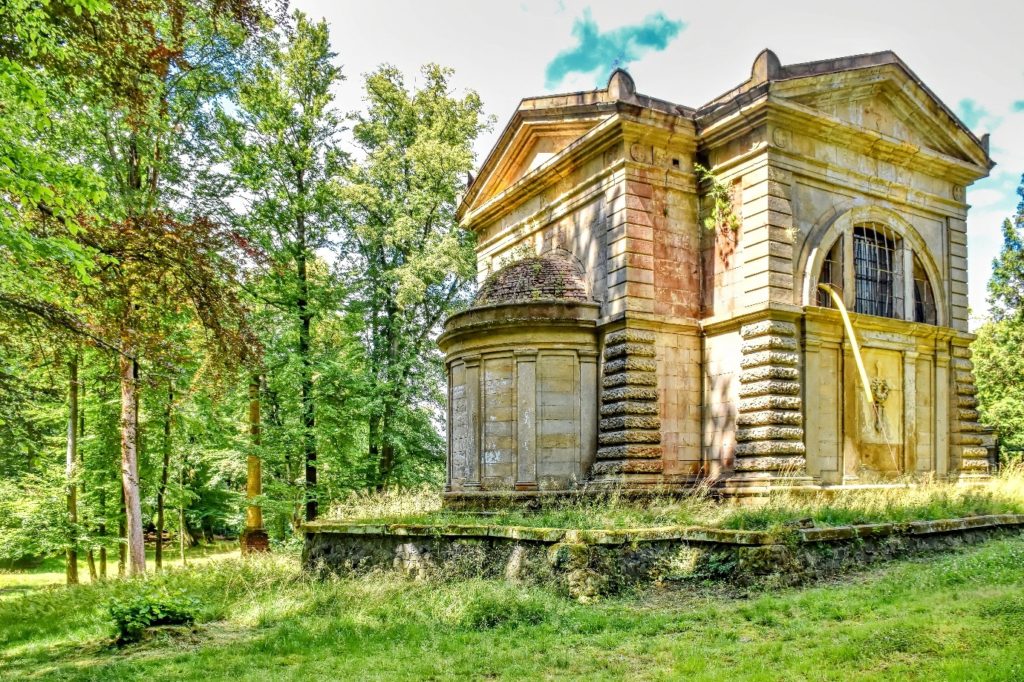
Dittrich’s tomb. You have already read about it several times in the Scapular, so this time we just wave in hope, that at least a fundamentally renovated building with a heating system, whose chimney can be seen further to the left of the tomb, has a bright future and that this rare gem can be saved and revived (if it is ausgerechten at the tomb an appropriate verb 

The trip is coming to an end. We drive through a beautiful city forest park…

…on the edge of which the last fifth pond awaits us, nameless this time.

Between the houses of Kamenná Horka we reach the famous Kögler’s Cross, which was constructed as two-sided, to the mental pleasure of the homestead owner and passers-by. In 1792 it was built by Josef Kögler, so innkeeper, for the homestead used to be an inn then.

which was originally built as a Lutheran church and only later became a Catholic stand. The Bohemian Cottage guest house kindly awaits us and asks, if we liked the round trip… Maybe we should tell him, born?
Published on: 2.1.2024 - Filed under: Blog

